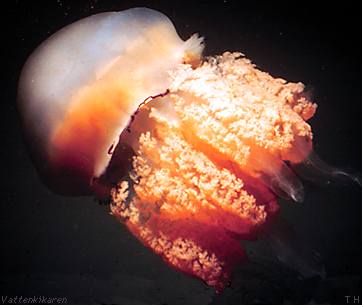|

Distribution in scandinavian waters
|
Maximum diametre:About 50 cm, but on rare occasions up to 90
cm.
Appearance: The top of the "umbrella" has a blueish colour, while
down on the outer edge small round pockets with a dark blue to violet
colour. The males sexual organs are blue, while the females are yellow,
brown or red. The medusae
have no tentacles. The
mouth arms have grown together and have about the same length as
the diametre of the "umbrella". The whole of the body has a relatively
solid consistency.
Compare the rhizostome jellyfish with the lion´s
mane jellyfish and the cyanea
lamarckii.
Depth: From sea-level to unknown depth.
Environment: Pelagic.
Misc: Rhizostome jellyfish can swim relatively quickly. The mouth
arms have an extensive system of canals. Through these water is pumped
and particles of food filtered out. There are stinging
cells on the "umbrella", but are so weak that they hardly irritate
human skin.
This species is rare in scandinavian waters, but medusae
have drifted into nordic
waters during the late summer and autumn.
Rhizostome jellyfish have in certain European areas been
used as a food source for people.
By reading the pages
about the moon jellyfish you can learn more about the
biology of the jellyfish.
Classification: The rhizostome jellyfish is a member of the jellyfish
group under the cnidarians.
|


